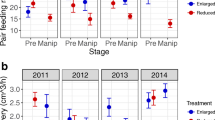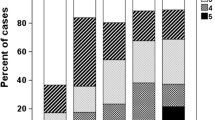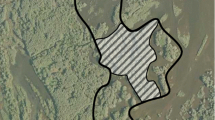Summary
Reproductive effort was compared among California gulls ranging in age from 3 to 18 years old. Results indicated that reproductive effort increased with parental age. Older parents (11–18 years old) invested more in foraging effort and in defense of offspring than did younger parents (<10 years old), and did so over a greater period of time. Increases with age in the efficiency of parenting could not be demonstrated. Increased levels of reproductive effort, therefore, appeared to be the main factor responsible for age-related increases in breeding success.
The higher levels of reproductive effort of old parents were associated with higher mortality. Thus, data support the prediction that a cost-benefit system of risk of mortality vs reproductive gain operates in this population. Higher levels of reproductive effort can increase an individual's reproductive success; however, it also increases the likelihood that it will die. Therefore, for the young parent, high risks of mortality involved in current production would be too costly (in terms of loss of future reproductive success) to justify the benefit of high current reproductive output. Parents achieve the highest likelihood of maximizing life-time reproductive output by increasing reproductive effort with age as the cost of mortality diminishes.
Data testing the relationship between parental age and reproductive effort demonstrate the existence of age-related variation in reproductive investment. They also demonstrate that the concept of reproductive value proposed by Fisher (1930) has validity as a framework which supports much of our theory on life history evolution.
Similar content being viewed by others

References
Anderson M, Wiklund CG, Rundgren H (1980) Parental defence of offspring: A model and an example. Anim Behav 28:536–542
Ashmole NP (1963) The regulation of numbers of tropical oceanic birds. Ibis 103:458–473
Behle WH (1958) The bird life of the Great Salt Lake. University of Utah Press, Salt Lake City
Brown RGB (1967) Breeding success and population growth in a colony of Herring and Lesser Black-backed Gulls, Larus argentatus and L. fuscus. Ibis 109:502–515
Butler RW, Verbeek NAM, Foottit RG (1980) Mortality and dispersal of the Glaucous-winged Gulls of southern British Columbia. Can Field Nat 94:315–320
Coulson JC (1966) The influence of the pair-bond and age on the breeding biology of the Kittiwake Gull Rissa tridactyla. J Anim Ecol 35:269–279
Coulson JC, Horobin J (1976) The influence of age on the breeding biology and survival of the Arctic Tern Sterna paradisaea. J Zool 178:247–260
Coulson JC, Wooller RD (1976) Differential survival rates among breeding Kittiwake Gulls, Rissa tridactyla (L.). J Anim Ecol 45:205–213
Davis JWF (1975) Age, egg-size and breeding success in the Herring Gull Larus argentatus. Ibis 117:460–473
Davis JWF, Dunn EK (1976) Intraspecific predation and colonial breeding in Lesser Black-backed Gulls Larus fuscus. Ibis 118:65–77
Fisher RA (1930) The genetical theory of natural selection. Clarendon Press, Oxford
Fisher RA (1958) The genetical theory of natural selection, 2nd edn. Dover, New York
Hunt GL Jr, McLoon SC (1975) Activity patterns of gull chicks in relation to feeding by parents: Their potential significance for density-dependent mortality. Auk 92:523–527
Kennedy JR (1973) A study of the breeding colony of California Gulls (Larus californicus), Bamforth Lake, Albany County, Wyoming. MS thesis, The University of Wyoming, Laramie
Lack D (1966) Population studies of birds. Clarendon Press, Oxford
Nettleship DN (1972) Breeding success of the Common Puffin (Fratercula artica L.) on different habitats at Great Island, Newfoundland. Ecol Monogr 41:239–268
Orians GH (1969) Age and hunting success in the Brown Pelican (Pelecanus occidentalis). Anim Behav 17:316–319
Parker GA, McNair MR (1978) Models of parent-offspring conflict. 1. Monogamy. Anim Behav 26:97–110
Patterson IJ (1965) Timing and spacing of broods in the Black-headed Gull (Larus ridibundus L.). Ibis 107:433–459
Pianka ER, Parker WS (1975) Age-specific reproductive tactics. Am Nat 109:453–464
Pugesek BH (1981) Increased reproductive effort with age in the California Gull (Larus californicus). Science 212: 822–823
Pugesek BH, Diem K (1981) Breeding strategies in California Gulls: Ages of mated pairs and the return rate to previous year's nest. Ohio J Sci 81:106
Pugesek BH, Diem KL (1983) A multivariate study of the relationship of parental age to reproductive success in California Gulls. Ecology (in press)
Richdale LE (1957) A population study of Penquins. Oxford University Press, London
Ryder JP (1975) Egg-laying, egg size, and success in relation to immature-mature plumage of Ring-billed Gulls. Wilson Bull 87:534–542
Sokal RR, Rohlf FJ (1969) Biometry. Freeman, San Francisco
Southworth DC (1976) A study of the eggs from the California Gull (Larus californicus) colony at Bamforth Lake, Albany County, Wyoming. MS thesis, The University of Wyoming, Laramie
Tets GF Van (1968) Seasonal fluctuations in the mortality rates of three northern- and three southern-hemisphere gulls. CSIRO Wildl Res 13:1–9
Trivers RL (1972) Parental investment and sexual selection. In: Campbell B (ed) Sexual selection and the descent of man, 1871–1971. Aldive, Chicago
Trivers RL (1974) Parent-offspring conflict. Am Zool 14: 249–264
Williams GC (1966a) Adaptation and natural selection: A critique of some evolutionary thought. Princeton University Press, Princeton
Williams GC (1966b) Natural selection, the costs of reproduction, and a refinement of Lack's principle. Am Nat 100:687–692
Wooller RD, Coulson JC (1977) Factors affecting the age of first breeding of the Kittiwake Rissa tridactyla. Ibis 119:339–349
Author information
Authors and Affiliations
Rights and permissions
About this article
Cite this article
Pugesek, B.H. The relationship between parental age and reproductive effort in the California Gull (Larus californicus). Behav Ecol Sociobiol 13, 161–171 (1983). https://doi.org/10.1007/BF00299919
Received:
Accepted:
Issue Date:
DOI: https://doi.org/10.1007/BF00299919



